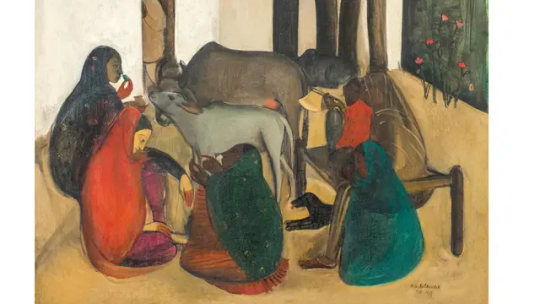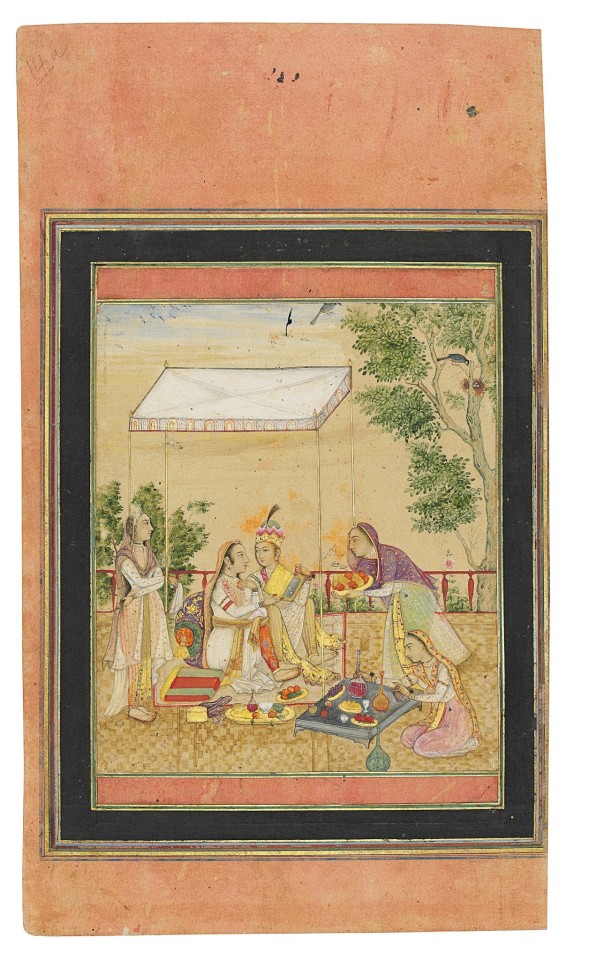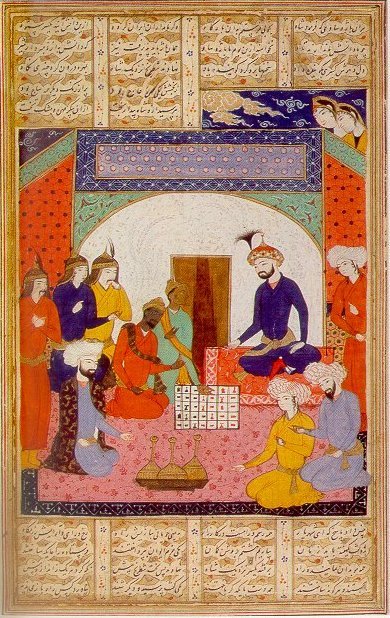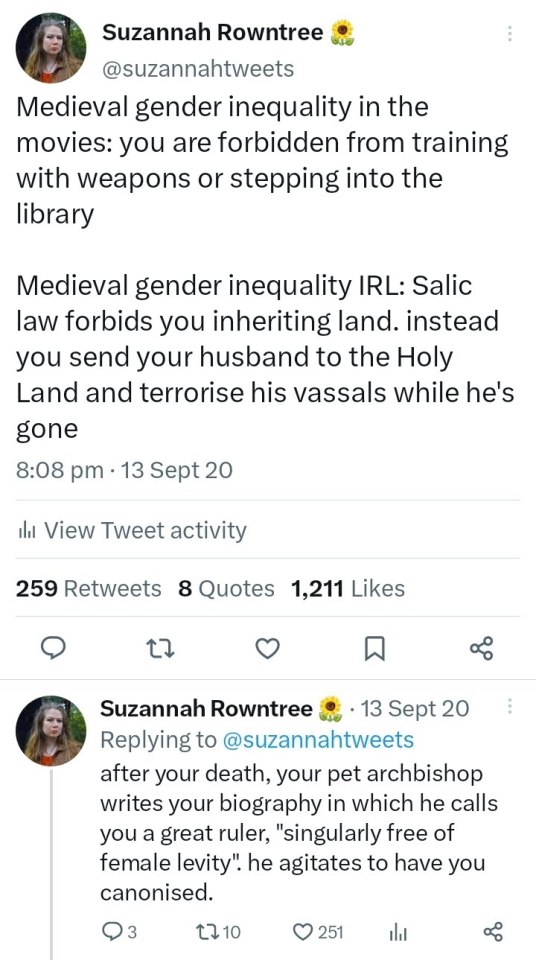#c: islamic
Explore tagged Tumblr posts
Text

كتاب السياسة في تدبير المملكة وحفظ الرياسة
#manuscript#medieval manuscript#كتاب السياسة في تدبير المملكة وحفظ الرياسة#sirr al-asrār#c: islamic#y: 1400s#l: arabic#t: page
3 notes
·
View notes
Text






art by amrita sher-gil
different art so y'all don't get drowned out by my chughtai glazing LMFOAOAOAO
#aesthetic#art#southeast asia#amrita sher gil#female beauty#female artists#female artwork#artworks#artwork#painting#paintings#a e s t h e t i c#islamic#cultural#culturalart#religious art#culture
26 notes
·
View notes
Text

"Couple with servants on a terrace" by Ali Quli Jabbadar, Safavid Iran, 1655-56
93 notes
·
View notes
Text
Sunan an Nasa’i: The Book of Zakah, Book 23, Hadith 2545
It was narrated from Abu Mas'ud that the Prophet said:
"When a man spends on his family, seeking reward for that, that is an act of charity on his part."
#allah#revert help team#islam#revert#revert help#muslim#god#convert to islam#welcome to islam#how to convert to islam#revert muslim#convert revert#revert islam#islam revert#new convert#convert#c
4 notes
·
View notes
Text
Lyft driver was speaking a Turkic language with Arabic interjections (yanni, inshallah, wallahi) and I've been trying to figure out which one it was for hours
#I'm basically narrowed down to Uzbek and Uyghur c/o other context clues but it is making me insane#I would have asked him but like. He was on the phone and I was not about to interrupt lol#He and the person he was talking to had names I associate with Uzbekistan and Kazakhstan#But he wasn't speaking Kazakh#And therefore given all the Arabic/Islam-adjacent interjections I'm skewing toward Uzbek or Uyghur
15 notes
·
View notes
Text
also like okay it's not like The Worst Thing In The World but I am disappointed that I found a book by a Mizrahi Jew that seemed like it'd be a very interesting read ("The Wrong Kind Of Jew: A Mizrahi Manifesto") because the Jewish world can be EXTREMELY Ashke-centric from what's considered stereotypically Jewish features to the Jewish branches (largely an Ashke thing, Mizrahim & Sephardim AFAIK don't really have branches) to traditional Jewish foods etc, and I googled the author (Hen Mazzig) to learn more about him and he's a a pretty hardcore Zionist who also pushes information not based in reality and like... again I'm not saying this is the worst thing in the world, but like... it's disappointing you know?
#noah.txt#idk I feel silly for being like... ''it's disappointing trying to find educational material related to my religion/ethnicity that#also isn't coming from someone whose beliefs directly impact my Palestinian loved ones AND Palestinians I don't know but care about#because I'm a human being who knows right from wrong and also knows that a country's existence is not more important than human life#which is ALSO congruent with Jewish philosophy/teachings so NO z*****t belief is NOT Jewish belief''#and like... it's also disappointing feeling alienated in religious Jewish circles b/c z*****m is treated like a fixed part of Judaism#it's not!!! it's fucking not!!! and it's like... how are RABBIS out here acting like absolute fucking CLOWNS#when they of all fucking people should know Judaism and Jewish belief/teachings! z*****m is NOT compatible with Jewish belief/teachings!#and like is this the first time people have misappropriated religion (even their OWN religion) to support their beliefs?#not at all! not at fucking all! but it doesn't change the fact that it IS disappointing and upsetting when your religion/ethnicity#(whether it's Judaism or Islam) is misappropriated by people/groups who twist it to support their beliefs
3 notes
·
View notes
Text
He killed a literal baby. And now he wants to sue the state for damages?!
By Anna Slatz February 14, 2024
A trans-identified male currently serving a 55-year sentence for the murder of his infant stepdaughter has launched a lawsuit against the Chaplain at his prison after he was allegedly denied a hijab despite identifying as a Muslim woman. Autumn Cordellioné, previously known as Jonathan C. Richardson, is seeking $150,000 in damages.
As previously reported by Reduxx, Cordellioné was first arrested in 2001 after his 11-month-old stepdaughter died in his care while her mother was at work. The night of the infant’s death, Cordellioné had been visited by friends who later told police that he had been “acting strangely.”
Despite claiming the little girl was inside sleeping, Cordellioné had loud music playing in the home, and his guests noted that he appeared to have a fresh, bleeding tattoo of the child’s name carved into his arm.

Autumn Cordellioné as of August 2023. Photo Courtesy: Indiana Department of Corrections.
Later that night, after his friends left, Cordellioné went to his neighbor and asked him to call 911, claiming the child was unresponsive. When emergency personnel arrived, they were briefly able to resuscitate the girl, but she died shortly after being rushed to the hospital.
Cordellioné was interviewed by police, who noted he was “calm and unemotional” during questioning, and his story about what happened to the baby changed dramatically over the course of the two interviews conducted.
At first, Cordellioné claimed he found the baby unresponsive after doing some household chores. But in the next interview, Cordellioné said the child was being “fussier than usual” and he attempted to throw her up in the air repeatedly in an effort to calm her down. He said her “head bopped forward and back up in a rough type of a manner,” and that the child continued to cry so he proceeded to shake her aggressively in an effort to calm her down.
During a failed appeals hearing, detectives from the case recounted how Cordellioné “physically showed” how he had manhandled the girl, getting up out of his chair and demonstrating the action in a rough manner.
An autopsy subsequently found that the baby had died of asphyxiation by manual strangulation. Cordellioné was booked awaiting a court hearing, and would later tell a prison official “all I know is I killed the little fucking bitch.”
Cordellioné was found guilty and sentenced to 55 years in prison for the horrific crime. He is currently incarcerated at the Branchville Correctional Facility, an institution for male offenders.
Last August, Cordellioné joined forces with the American Civil Liberties Union to sue the Indiana Department of Corrections, citing “discrimination” on the basis of his gender identity. That case is currently in progress.
But Reduxx has now learned that that Cordellioné has also launched a separate suit against the prison’s Chaplain, Tony Gray. Gray has been a Chaplain at the facility since 2014, and volunteered at the institution prior to being offered an official role.

Branchville Chaplain Tony Gray. Photo Source: Indiana Department of Corrections
In the lawsuit, filed on November 3, 2023, Cordellioné accuses Gray of violating his First, Eighth, and Fourteenth Amendment constitutional rights.
According to court records obtained by Reduxx, the incident of complaint took place in May of 2023 after Gray informed Cordellioné that he was not allowed to don a hijab outside of his cell. In response, Cordellioné said: “I wear the hijab in order to cover my head and ears for modesty purposes, as I am an Islamic practicing transwoman.”
At the time, Cordellioné’s registered religion was “Wiccan” and Gray pointed that out, to which Cordellioné replied that he was an “eclectic practitioner who is a member of the Theosophical Society in America.”
The Theosophical Society is headquartered in Chennai, India, and is considered an “esoteric new religious movement.” Founded in 1875, it describes itself as a “unsectarian body of seekers after Truth,” and its practitioners appear to dabble in the philosophy and beliefs of multiple religions simultaneously. One of its founders is Russian mystic Helena Petrovna Blavatsky, who stated in 1889 that “the purpose of establishing the Society was to prepare humanity for the reception of a World Teacher.”
Cordellioné is claiming that his equal protection rights were violated when he was barred from wearing a hijab outside of his cell, noting that male Muslims in the facility are allowed to wear kufis or taqiyah — a short, rounded brimless prayer cap.
“Islamic faith mandates the wearing of a kufi for males … Islamic faith also mandates females of the faith wear hijabs when outside the home and when not amongst men of their family. Tony Gray allows male Muslims to wear their sufis, but denies me, a transwoman, the same privilege.”

From the legal complaint filed by Cordellioné.
Cordellioné also alleges that Gray’s refusal to allow him to wear a hijab violated his eighth amendment rights against cruel and unusual punishment. In his argument, Cordellioné claims the he was subjected to “harassment and ridicule” by the Islamic community in his prison because he had not been allowed to wear a hijab.
“[Gray] should be aware, as Chaplain, the stigma and shame that is attributed to Islamic women when they go uncovered and without a hijab,” Cordellioné writes in his complaint. “Women are viewed as whores, tempters of men, and adulterators; by Islamic society both in and out of prison. I have been shunned, made a social pariah, and amongst my own religious community.”
He continues: “Without the support of the Islamic community, I will struggle and likely fail to achieve salvation for by [sic] Mohammed’s teachings a Muslim who knows of the teachings, yet strays from them, will never reach heaven.”
In his stated request for relief, Cordellioné is seeking the ability to wear his hijab in prison, as well as $150,000 in compensation.
Since filing, there has been some back-and-forth with the court surrounding Cordellioné’s financial situation, with the court requesting a nominal initial filing fee of $36.55, but Cordellioné claiming he does not have the money to pay it. If he cannot demonstrate deficiency in the time the court has specified, his case might be dismissed.
#Autumn Cordellioné is Jonathan C. Richardson#Criminals using gender identity to try to look like the victim#Branchville Correctional Facility#American Civil Liberties Union#ACLU defending violent men who claim to be women#Indiana Department of Corrections#Good for the Chaplin for standing up to a guy claiming to be an Islamic practicing transwoman#Theosophical Society in America#A lot of muslim men would not like him wearing a hijab#He wants to identify as a whole tempter of men and an adulteress?#Another guy who fetishizes submissiveness#He claimed to be Wiccan first#He's really trying to check of as many boxes for an oppression Olympics
12 notes
·
View notes
Text







Mekka, mit bilder-atlas - NYPL Digital Collections
Photography: Dr. Abdelghaffar Baghdadi
Hurgronje, C. Snouck (Christiaan Snouck), 1857-1936 (Author)
Date Issued: 1888 - 1889Place: HaagPublisher: M. Nijhoff
يكتب لنا المستشرق الهولندي الشهير، كرستيان سنوك هورخرونيه، عن رحلته في مكة المكرمة والتي دخلها عن طريق تسمية نفسه بأسم مستعار، وبقي في مكة حتى أغسطس عام 1885م، وألف هذا الكتاب خلال رحلته هذه، وهو عبارة عن جزئين، يتحدث الكاتب في الجزء الأول عن الوضع السياسي لمكة المكرمة في الفترة التي كان فيها هناك ويسرد لنا الكثير عن تاريخها السياسي. وفي الجزأ الثاني يحدثنا كرستيان سنوك عن الوضع الاجتماعي الذي رآه وعاش فيه في مكة المكرمة.
مؤلف: ك. سنوك هورخرونيه
التصوير: هرخرونيه التقى بمكة بطبيب ، اسمه كذلك عبد الغفار البغدادي وعلمه صنعت التصوير وعلى ذلك فكثير من الصور هي من تصوير عبد الغفار البغدادي لا هرخرونيه
#عبد الغفار البغدادي#مكة#تاريخ#كتاب#الحج#الإسلام#النوادر#الاستشراق#Hurgronje#C. Snouck#Christiaan Snouck#mecca#mekkah#islam#history#oriental#israel#concentration camp#auschwitz#genocide#artwork#artists on tumblr#drawing#Illustration
4 notes
·
View notes
Text

Persian manuscript describing how an ambassador from India, probably sent by the Maukhari King Śarvavarman of Kannauj, brought chess to the Persian court of Khosrow I.
The same scene from another manuscript.An illustration from a Persian manuscript "A treatise on chess". The Ambassadors from India present the Chatrang to Khosrow I Anushirwan, "Immortal Soul", King of Persia
From Wikipedia: https://en.wikipedia.org/wiki/History_of_Iran#/media/File:A_treatise_on_chess_2.jpg
#iran#india#iranian#persia#persian#chess history#chess#Maukhari#sasanian empire#sasanian dynasty#pre-islam persia#medieval#6th c. persia#6th century
6 notes
·
View notes
Text
also said it about a million times before. but this idea that "science" is inherently incompatible with the nonwestern world bc it is inherently western is not only outright bogus but racist and especially more noble savage shit
the west did not invent science. the west was very very far from being the only place on this planet to have an insanely complex understanding of the solar system, of very complex medicine (western europeans learned how to perform c-sections from africans btw), of traditional medicine, or mathematics and physics, and whatever else
#fucks sake the west still has like no idea why so much of traditional chinese medicine practices Very Clearly Work#and western euro doctors bothched about a million c-sections before they got it right while african women had very high rates of success#also#the islamic golden age?? hello
6 notes
·
View notes
Text
L'Opera Parallela
L’Opera Parallela: cinque volumi per la costruzione filosofica del paradigma del dissenso e l’invocazione di una vita normale di livello umano, partendo dall’assunto che la vita si svolge ordinariamente per consentire un livello subumano, dove nemmeno le cose più ovvie prendono significato, la sopraffazione ha il sopravvento e le guerre sono testimonianza di quest’era contemporanea così lontana…
#armi#buco#c.#ceccoli#come#crimi#cristianesimo#croce#davide#dell&039;eden#dio#disarmo#dissenso#ebraismo#eden#filosofia#illuminismo#islam#l&039;occhio#libri#Libro#mezzi#nel#nero#occulte#opera#origini#parallela#poesia#politico
0 notes
Text
IRS calls terrorist front a charity
Brothers and Sisters;
The Council on American Islamic relations (CAIR), an organization US Air Force Investigator and Investigative reporter David Gaubatz called a "Muslim Mafia," is a proven front for the terrorist organization Hamas, and according to the Justice department an "unindicted co-conspirator" in the Holy Land terrorist financing trial, CAIR Is listed by the IRS as a 501 (c) (3) tax exempt charity. As such they are eligible to receive donations from foundations that are also. Some of the foundations that have made donations to CAIR include American Online Giving Foundation, the California Endowment, the Weingart Foundation, Schwab Charitable Fund, Asian Americans Advancing Justice, East Bay Community Foundation and many others.
Fortunately there are remedies available to informed and concern citizens. Any citizen can complain that an undeserving organization is enjoying tax exempt status by.
One of these two processes the public can use to notify the IRS of perceived violations by tax-exempt organizations. The first, which has no specific statutory basis, is Form 13909, which the IRS released in 2007.
If you suspect a tax-exempt organization is not complying with the tax laws, you may send information to the Tax Exempt and Government Entities Division. You may use Form 13909, Tax-Exempt Organization Complaint (Referral) Form PDF, or send the information in letter format, and attach any supporting documentation for this purpose. Form 13909 PDF, or complaint letter, can be submitted one of the following ways:
Email to [email protected], or
Mail to TEGE Referrals Group, 1100 Commerce Street, MC 4910 DAL, Dallas, TX 75242
0 notes
Text

Jusuf and Zuleykha by Muhammad Nadir Samarqandi, 1630s; Mughal Indian art
43 notes
·
View notes
Text
Sunan an Nasa’i: The Book of Zakah, Book 23, Hadith 2524
t was narrated from Abu Al-Malib that his father said:
"I heard the Messenger of Allah say: 'Allah, the Mighty and Sublime, does not accept prayer without purification or charity from Ghulul."
#allah#revert help team#islam#revert#revert help#muslim#convert to islam#welcome to islam#how to convert to islam#god#revert to islam#revert muslim#convert revert#new convert#convert#c
2 notes
·
View notes
Text

all RIGHT:
Why You're Writing Medieval (and Medieval-Coded) Women Wrong: A RANT
(Or, For the Love of God, People, Stop Pretending Victorian Style Gender Roles Applied to All of History)
This is a problem I see alllll over the place - I'll be reading a medieval-coded book and the women will be told they aren't allowed to fight or learn or work, that they are only supposed to get married, keep house and have babies, &c &c.
If I point this out ppl will be like "yes but there was misogyny back then! women were treated terribly!" and OK. Stop right there.
By & large, what we as a culture think of as misogyny & patriarchy is the expression prevalent in Victorian times - not medieval. (And NO, this is not me blaming Victorians for their theme park version of "medieval history". This is me blaming 21st century people for being ignorant & refusing to do their homework).
Yes, there was misogyny in medieval times, but 1) in many ways it was actually markedly less severe than Victorian misogyny, tyvm - and 2) it was of a quite different type. (Disclaimer: I am speaking specifically of Frankish, Western European medieval women rather than those in other parts of the world. This applies to a lesser extent in Byzantium and I am still learning about women in the medieval Islamic world.)
So, here are the 2 vital things to remember about women when writing medieval or medieval-coded societies
FIRST. Where in Victorian times the primary axes of prejudice were gender and race - so that a male labourer had more rights than a female of the higher classes, and a middle class white man would be treated with more respect than an African or Indian dignitary - In medieval times, the primary axis of prejudice was, overwhelmingly, class. Thus, Frankish crusader knights arguably felt more solidarity with their Muslim opponents of knightly status, than they did their own peasants. Faith and age were also medieval axes of prejudice - children and young people were exploited ruthlessly, sent into war or marriage at 15 (boys) or 12 (girls). Gender was less important.
What this meant was that a medieval woman could expect - indeed demand - to be treated more or less the same way the men of her class were. Where no ancient legal obstacle existed, such as Salic law, a king's daughter could and did expect to rule, even after marriage.
Women of the knightly class could & did arm & fight - something that required a MASSIVE outlay of money, which was obviously at their discretion & disposal. See: Sichelgaita, Isabel de Conches, the unnamed women fighting in armour as knights during the Third Crusade, as recorded by Muslim chroniclers.
Tolkien's Eowyn is a great example of this medieval attitude to class trumping race: complaining that she's being told not to fight, she stresses her class: "I am of the house of Eorl & not a serving woman". She claims her rights, not as a woman, but as a member of the warrior class and the ruling family. Similarly in Renaissance Venice a doge protested the practice which saw 80% of noble women locked into convents for life: if these had been men they would have been "born to command & govern the world". Their class ought to have exempted them from discrimination on the basis of sex.
So, tip #1 for writing medieval women: remember that their class always outweighed their gender. They might be subordinate to the men within their own class, but not to those below.
SECOND. Whereas Victorians saw women's highest calling as marriage & children - the "angel in the house" ennobling & improving their men on a spiritual but rarely practical level - Medievals by contrast prized virginity/celibacy above marriage, seeing it as a way for women to transcend their sex. Often as nuns, saints, mystics; sometimes as warriors, queens, & ladies; always as businesswomen & merchants, women could & did forge their own paths in life
When Elizabeth I claimed to have "the heart & stomach of a king" & adopted the persona of the virgin queen, this was the norm she appealed to. Women could do things; they just had to prove they were Not Like Other Girls. By Elizabeth's time things were already changing: it was the Reformation that switched the ideal to marriage, & the Enlightenment that divorced femininity from reason, aggression & public life.
For more on this topic, read Katherine Hager's article "Endowed With Manly Courage: Medieval Perceptions of Women in Combat" on women who transcended gender to occupy a liminal space as warrior/virgin/saint.
So, tip #2: remember that for medieval women, wife and mother wasn't the ideal, virgin saint was the ideal. By proving yourself "not like other girls" you could gain significant autonomy & freedom.
Finally a bonus tip: if writing about medieval women, be sure to read writing on women's issues from the time so as to understand the terms in which these women spoke about & defended their ambitions. Start with Christine de Pisan.
I learned all this doing the reading for WATCHERS OF OUTREMER, my series of historical fantasy novels set in the medieval crusader states, which were dominated by strong medieval women! Book 5, THE HOUSE OF MOURNING (forthcoming 2023) will focus, to a greater extent than any other novel I've ever yet read or written, on the experience of women during the crusades - as warriors, captives, and political leaders. I can't wait to share it with you all!
#watchers of outremer#medieval history#the lady of kingdoms#the house of mourning#writing#writing fantasy#female characters#medieval women#eowyn#the lord of the rings#lotr#history#historical fiction#fantasy#writing tip#writing advice
30K notes
·
View notes
Text
A. C. S. Peacock – Moğol Anadolu’sunda İslam, Edebiyat ve Toplum (2023)
Tarihçi A. C. S. Peacock, ‘Moğol Anadolu’sunda İslam, Edebiyat ve Toplum’da, yaklaşık 1240 ile 1380 yılları arasında Moğol egemenliği altındaki Anadolu’yu ele alıyor. Çoğu daha önce yayımlanmamış Arapça, Farsça ve Türkçe kaynakları bir araya getirerek Osmanlı İmparatorluğu’nun ve nihayetinde modern Türkiye’nin doğuşunun temellerini oluşturacak Ortaçağ Anadolu’sunu inceliyor. Bu önemli ama göz…

View On WordPress
#2023#A. C. S. Peacock#Koç Üniversitesi Yayınları#Moğol Anadolu’sunda İslam Edebiyat ve Toplum#Renan Akman
0 notes